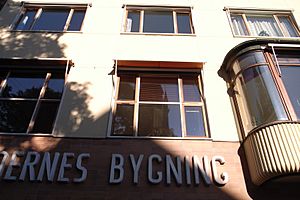Ragna Grubb facts for kids
Ragna Grubb (born March 20, 1903, in Copenhagen; died June 9, 1961, in Frederiksberg) was a talented Danish architect. She is famous for being one of the first women in Denmark to start her own architecture business. Ragna Grubb was also very interested in designing affordable homes for families in the 1930s.
Contents
Ragna Grubb's Early Life and Education
Ragna Grubb finished high school at Nørre Gymnasium in 1921. Even as a child, she loved architecture. After a long trip to Italy and Switzerland, where she studied many old buildings, she knew she wanted to become an architect.
In 1922, she went to a technical school. The next year, she was accepted to study architecture at the Danish Academy. She graduated in 1933. While she was studying, she also worked part-time with other architects like Kaj Gottlob, Povl Baumann, and Knud Sørensen.
Ragna Grubb's Architecture Career
Starting Her Own Architecture Studio
In 1935, Ragna Grubb opened her own architecture studio. This was very unusual for women architects at that time. She was able to do this because she won a big competition in 1934. The competition was to design a building called Kvindernes Bygning, which means "The Women's Building."
Designing The Women's Building
The Women's Building was planned for Niels Hemmingsens Gade in Copenhagen. The idea was to create a place where women involved in good causes and charity work could meet. It would also be a place for people who supported these causes.
The building was finished in 1936. It was made of ferro-concrete, a strong material. It had a hotel, offices, and meeting rooms. The outside of the building had windows placed horizontally. The top floor was set back a bit. The design used the newest ideas of the time, in a style called Functionalist. This style focuses on how useful a building is and uses simple, clean lines.
Focus on Social Housing
In 1937, Ragna Grubb won another important prize. She worked with Karen Hvistendahl and Ingeborg Schmidt in a competition for the Foreningen Socialt Boligbyyeri (Social Housing Association). They won first prize for their designs of homes for families who didn't have a lot of money.
Designing social housing became Ragna Grubb's main passion. She strongly believed in creating apartments with two or three small bedrooms. She also liked more open layouts than the traditional two-room apartments. These new designs were much better for working-class families with several children.
She also thought about the inside of the apartments. She designed the interior decoration and furniture. She often used light wooden furniture to make the spaces feel bright and welcoming. Between 1939 and 1940, she completed one of the large social apartment buildings in Bispebjerg.
Later Work and Family Life
In 1937, Ragna Grubb married an architect named Christian Laursen. He sometimes helped her with her projects. However, he usually had his own work to do. As Ragna Grubb spent more time with her family, her later work focused on designing a few private homes and summer houses. She also worked on restoring old buildings.
See also
 In Spanish: Ragna Grubb para niños
In Spanish: Ragna Grubb para niños


